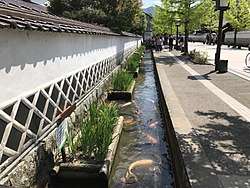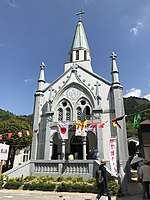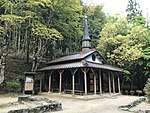Tsuwano
Tsuwano (津和野町) is a town in Shimane Prefecture, Japan. It's on the border with Yamaguchi Prefecture. It's sometimes referred to as "Little Kyoto" and is well known for having tens of thousands of koi (carp) that live in the narrow canals that run through town, mostly in the Tonomachi area.
Get in
By train
Tsuwano is on the JR Yamaguchi Line, which branches from the San'in Main Line at Masuda and terminates at Shin-Yamaguchi, the closest shinkansen stop. Much of the year a train pulled by a steam locomotive (SL Yamaguchi-gō) built in the early 1900s that runs once a day on weekends (daily in July and August) between Shin-Yamaguchi station and Tsuwano.
There are six incoming and six outgoing trains each day (3 local and 3 super ooki in each direction).
By bus
There are buses to and from local and regional destinations. There are also overnight buses to some large cities such as Osaka and Tokyo (Shinjuku Station New South exit).
Get around
Much of Tsuwano can be easily accessed by foot. There are some bicycles for rent across the street from Tsuwano Station and usually there are several taxi's waiting in front of the station as well.
See
Districts

- Tonomachi - This is the main site seeing road with numerous shops and some old samurai houses. One the side of the main Tonomachi streets are canals lined with large carp. There are also numerous food and product stands.
- Tsuwano Castle (津和野城跡) was built around 1395 and demolished during the Meiji Restoration, five and a half centuries later. The stone foundations are pretty much all that remains, but the summit offers views over the valley and town. It can be reached via chair lift (¥450, 10AM-5PM) near Taikodani Inari Jinja; alternatively, from Taikodani, walk down to the car park and along the road ~50m, then follow a small path on your right — the walk will take around 30 minutes.
Shrines, Temples and Other Religious Buildings


- Tsuwano Catholic Church (津和野天主教會) - a nice church with tatami mat floors and if you go on a fine day the sunshine shines through the stained glass windows; very good for photos. You can also pick up a copy, for a small fee, of the story of the Otome-Toge Matyrs. Carp food is also available to buy.
- Chapel of Saint Maria (瑪麗亞教堂), Ushiroda, Tsuwano-cho, ☎ +81 856-72-0251. 7:30AM-5PM. In the area known as Otome-toge (Otome Pass) behind the station. 36 Japanese Christians were tortured and killed here during the Meiji Period. When Japan "opened" to the West, many Japanese Christians mistakenly thought that meant it was okay to come out and admit their faith but Christianity was still illegal, so those found to be Christian were taken here (and to other special places) and killed. This small church is run as a memorial to them.
- Taikodani Inari Jinja (太皷谷稻成神社), 409 Ushiroda, Tsuwano-cho, ☎ +81 856-72-0219. One of the Five Great Inari Shrines. It was built in 1773 by Tsuwano's seventh generation feudal lord Kamei Norisada to enshrine a share of the rice spirit Inari worshipped at Fushimi Inari in Kyoto. The walk up the mountain-side, through over a thousand bright red torii (gates), leads to a great view over the town. Free.
- Washibara Hachiman-gu Shrine - a small shrine on the edge of town. It has archery contests on the 2nd of April. It is a pleasant walk through the garden.
- Yomei-ji Temple - Built in 1420, it is one of the 2 great Soto sect temples. It was the family temple for many of the Tsuwano feudal lords and has the Mori Ogai's grave.
Other Places of Interest
- Tsuwano Japan Heritage Center, Tonomachi Road. A small museum and tourism information center. The visitors can learn about the history of Tsuwano through "100 views of Tsuwano Then and Now", which is a collection of drawings showing Tsuwano's townscape as it was 150 years ago. Many places, the scenery remained, so one can compare the old and the new. A full size costume of the Heron dance (Sagimai) is exhibited on the 1st floor. The staff speaks fairly good English. Entrance is free! (The Katsushika Hokusai Museum of Art closed permanently, and the same building became the Tsuwano Japan Heritage Center)
- Anno Museum of Art - Art museum that specialises in Mitsumasa Anno, who was born in Tsuwano. There is also a planetarium, a reproduction of Anno's home studio space and an old 1930s style elementary school classroom.
- Hori Tei-en - While not near the center of town, this is a great place to visit. The residence of the Hori family, the estate consists of a main building, a very beautiful garden, and guest house. Open 8AM-5PM. (9AM-4PM during winter season). From Tsuwano station take the Iwami Kotsu Bus for Nagano. Get off at Hori Teien (23 min.)
Do
- SL Train - Two authentic early 1900s steam locomotives run once daily (only 1 train a day) on weekends and on national holidays (except in the winter) from Shin Yamaguchi (formerly Ogori) station to Tsuwano and back. It only stops for about three hours in Tsuwano before returning to Shin Yamaguchi station.
- April - Yabusame In the spring, when the Cherry blossoms are in bloom, men in bright outfits take part in a horseback archery festival in front of Washibara-hachiman-gu Shrine, about 4 km from Tsuwano station.
- May 3 - Otome-toge Festival A procession from Tsuwano Catholic Church in Tono-machi to Maria Cathedral at Otome-toge Pass is followed by a mass at the square in front of the cathedral.
- July 20, 24, 27 - Gion Festival Men in white bird outfits perform graceful dances to the music of bells, flutes and drums. This festival is held to worship the gods at Yasaka Shrine. At the same time, another group made up of young children in costumes proceed along Tonomachi, the station vicinity, and the city outskirts.
- August 15 - Bon Odori A black scarf, white head band, white short kimono, and black tights are worn by Tsuwano Odori dancers. This dance began in the Muromachi period (1336 - 1573) in memory of the dead and is now recognized as an intangible cultural asset of Shimane Prefecture.
Buy
There are at least 3 sake factories, 2 of which are on Tonomachi road. Tsuwano has made washi (paper) for hundreds of years. The souvenir shops sell many kinds of paper and dolls made of paper. There is also a shop near Tsuwano High School that makes paper in the traditional way. For a fee, you can make some paper yourself and keep what you made. The souvenir shops also sale various kinds of traditional pickles. Tsuwano also sells Genji-maki, a kind of pancake wrapped around sweet beans.
Eat
Many visitors come through on tour buses, so most restaurants serve lunches but close early in the evening. If you are staying overnight in Tsuwano and your accommodation does not include meals, take care not to leave eating until too late.
- Pomme Souffle, is an Italian restaurant with delicious and authentic Italian appetizers, pizzas, pasta, and pastries, as well as a large collection of international liquors. This is one of the few restaurants open past 6PM. Located across the street from the post office further up the main tourist road heading towards the station.
- Furusato, is a small restaurant opposite the post office near the Tonomachi district. There are western style tables or Japanese. At this restaurant you can order a locally specialty of Uzume-meshi, which is a soupy rice dish served with wasabi small pieces of mountain vegetables and tofu.
- Tsurube, is a small Udon-only restaurant located on Ushiroda street, clustered with other small noodle and okonomiyaki shops. The owner is a former Yabusame (Horse-back) Archer, and the shop is littered with his old photographs and shattered wood targets. Top class, but slightly pricey, udon of all kinds can be found here.
- Naniwa, is an Osaka-style restaurant specializing in Okonomiyaki (Naniwa is the ancient name of Osaka). It is owned and operated by the brother of the neighboring Tsurube Udon-ya, and aside from having tableside grittle-cooked okonomiyaki, also serves a variety of soba/udon/noodle dishes, as well as having a larger back room for parties of more than 6.
- Aoki Sushi, is one of two sushiyas in Tsuwano, located just down the street from the main train-station. It has an elegant traditional Japanese style, multiple tatami-based back rooms, as well as a central seating room and small sushi bar. A great place for delicious and relatively low-priced Sushi.
Drink
Sleep
Koraku (幸楽) is a somewhat run down ryokan hotel where little seems to have changed since the early 1960s. It definitely has character, but sadly few guests. Go up the main street from the station and turn left just after the hospital. Tel. 0856-72-0501. ¥10,500 for a tatami style room with attached toilet and bath including breakfast only.
- Star Inn (民宿星旅館), 53-6 Oaza Ushiroda, ☎ +81 856-72-0136. Family ryokan just a minute from JR Tsuwano Station. Rooms from ¥6500, includes breakfast and dinner.
- Noren-yado Meigetsu (明月メイゲツ), 665 Oaza-Ushiroda, Tsuwano-cho, ☎ +81 856-72-0685. Very nice ryokan just off Tonomachi. Some rooms have own bath; others just use the ofurou. Rooms from ¥10,500, includes breakfast and dinner.
Go next